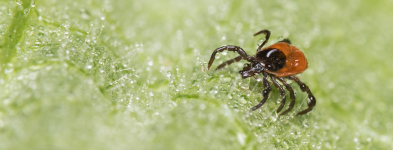

4 minute read
Could it be alpha-Gal Syndrome?
Published May 4, 2024
Stemming from a tick bite, alpha-Gal Syndrome can cause the immune system to confuse a sugar found in red meat for an enemy—leading to delayed and potentially severe allergic reactions.¹
What’s alpha-Gal Syndrome?
Tick bites can trigger a surprising allergy called alpha-Gal Syndrome (AGS). AGS is also called alpha-Gal allergy, red meat allergy, or tick bite meat allergy.¹
It can happen like this¹:
- A tick feeds on a mammal (like a deer) and picks up a sugar called alpha-Gal.
- If that tick then bites a person, it can pass some of that sugar into the person's bloodstream.
- The person’s immune system sees the sugar as something that shouldn’t be there. So, it responds by making antibodies to fight off the invaders. This initial exposure to alpha-Gal usually doesn't cause any symptoms.
- Later, when the person eats red meat, organ meats, or other mammalian products (like milk), their immune system—now ready to react to alpha-Gal—causes an allergic reaction. The allergic reaction can be mild, severe, or even life threatening. The catch? Symptoms often show up hours after eating, making it easy to miss the connection.


What are the symptoms of alpha-Gal Syndrome?
Unlike most food allergies, symptoms of AGS don't show up right away. Instead, it can take at least 2 hours—and sometimes up to 5 hours or longer—for a reaction to occur. This delayed allergic reaction can make it difficult to figure out that alpha-Gal is to blame.¹
Signs and symptoms of alpha-Gal Syndrome can include¹
- Sneezing
- Itchy rash
- Hives
- Headache
- Stomach pain
- Diarrhea
- Vomiting
- Swelling
- Wheezing or shortness of breath
- Anaphylaxis (pronounced an-uh-fuh-lak-sis)
Up to 60% of people with alpha-Gal Syndrome experience severe allergic reactions, like anaphylaxis.¹
Anaphylaxis is when the body has a severe, life-threatening allergic reaction. It requires immediate emergency assistance.²
Signs and symptoms of an anaphylactic reaction can include: difficulty breathing, swelling (throat, tongue, lips), severe drop in blood pressure, dizziness, or fast heart rate.²
If you experience symptoms of an anaphylactic reaction—call 911 or go to the nearest emergency room immediately.
What exactly is alpha-Gal?
Alpha-Gal is a type of sugar that humans don't naturally have. But it's found in the bodies of most mammals like cows, pigs, and deer. This means it's also in meat from these mammals and some other products made from them, like dairy and gelatin. Eating these products can trigger allergic reactions in people with AGS.¹
Below are some foods or products where alpha-Gal can be found[¹ ³]:
- Beef
- Pork
- Rabbit
- Lamb
- Goat
- Venison
- Bear
- Organ meats
- Dairy products (milk, cheese, yogurt)
- Gelatin made from beef or pork (gummy candies, marshmallows, gelatin desserts)
- Lard and tallow
- Certain medications, vaccines, and gelcaps
Alpha-Gal isn’t naturally found in chicken, turkey, duck, quail, fish, shellfish, seafood, or fruits and vegetables.³
A study found that nearly 80% of people with alpha-Gal Syndrome struggled—for over 7 years—to find a diagnosis.⁴
Does cooking meat get rid of alpha-Gal?
No, cooking meat doesn’t get rid of alpha-Gal. Even if the meat is cooked to a "well done" state, it doesn’t eliminate the alpha-Gal sugar molecule. The cooking temperature, no matter how high or how long the meat is cooked, won't destroy the molecule. This means that all forms of mammalian meat—regardless of cooking method, whether it's grilled, boiled, fried, or baked—can cause symptoms in sensitive individuals. And some people might even have symptoms after inhaling meat fumes.¹ ⁴
What types of ticks are linked to alpha-Gal Syndrome?
So far, 8 types of ticks are suspected carriers.⁴ But lone star ticks hold the strongest link to AGS. They are found in many parts of the eastern, southeastern, and south-central US.⁵ Look for these signs to identify adult lone star ticks⁶:
- Females: A single white dot or "lone star" on their backs
- Males: White spots or streaks around the outer part of their bodies
Is alpha-Gal Syndrome like Lyme disease?
Tick bites are behind both AGS and Lyme disease, but they aren’t the same. AGS is an allergy to foods containing alpha-Gal that can develop after a tick bite.¹ Lyme disease is a bacterial infection spread to a person through the bite of an infected tick.⁷
How could alpha-Gal trigger an immune response?
The sugar molecule alpha-Gal, commonly found in red meat, usually doesn't cause problems. But for those with AGS, their immune system reacts differently. It sees alpha-Gal as something harmful and makes special defenders, known as antibodies, to fight it. These defenders are called immunoglobulin E (pronounced im-mew-no-glob-you-lin E), or IgE for short. These antibodies stick to cells in areas like the skin, lungs, and digestive system, ready to defend against alpha-Gal. And should alpha-Gal reappear, they'll be prepared to sound the alarm.
Now, suppose this person eats food containing alpha-Gal. These “remembering” IgE antibodies recognize it and sound the alarm by triggering an allergic response. This causes the cells to release chemicals like histamine. This reaction is what can cause allergy symptoms like hives, itching, diarrhea, swelling, or even anaphylaxis.⁸ ⁹
Alpha-Gal IgE blood test
Quest’s Alpha-Gal Syndrome Allergy Panel looks for certain IgE antibodies in your blood. These markers increase when your body reacts to alpha-Gal and 3 red meat allergens: beef, lamb, and pork.
If the test finds a high level of these specific antibodies, it means you might have an allergy to alpha-Gal, beef, lamb, and/or pork. This could explain symptoms like hives, stomach upset, or other allergic reactions that happen a few hours after eating red meat or other mammal products. The results can help you and your doctor work together to understand if your symptoms are caused by alpha-Gal Syndrome.
► Only a doctor can diagnose an allergy and prescribe medication, if needed.
No doctor visit is required to buy your own lab test at questhealth.com. PWNHealth and its affiliates review your purchase to ensure it is medically appropriate before submitting the test order for processing. PWNHealth also reviews your test results and will contact you directly if they require prompt attention. Included in each purchase is the option to discuss your test results with an independent physician; however, you are also encouraged to speak with your primary healthcare provider.
Tests featured in this article:
References
- Thermo Fisher Scientific. Alpha-gal Syndrome. Accessed March 5, 2024. https://www.thermofisher.com/allergy/us/en/allergen-fact-sheets/alpha-gal-syndrome.html
- Cleveland Clinic. Anaphylaxis. Accessed March 5, 2024. https://my.clevelandclinic.org/health/diseases/8619-anaphylaxis.
- Centers for Disease Control and Prevention (CDC). Products that may contain alpha-gal. Accessed March 5, 2024. https://www.cdc.gov/ticks/alpha-gal/products.html
- Thermo Fisher Scientific. 10 new and surprising facts about alpha-gal syndrome. Accessed March 5, 2024. https://www.thermofisher.com/allergy/us/en/living-with-allergies/food-allergies/10-new-and-surprising-facts-about-alpha-gal-syndrome.html?cid=0em_swp_01112021_FCPWNW
- Centers for Disease Control and Prevention (CDC). Regions where ticks live. Accessed March 5, 2024. https://www.cdc.gov/ticks/geographic_distribution.html
- Centers for Disease Control and Prevention (CDC). Tick ID. Accessed March 5, 2024. https://www.cdc.gov/ticks/tickbornediseases/tickID.html
- Centers for Disease Control and Prevention (CDC). Lyme disease. Accessed March 5, 2024. https://www.cdc.gov/lyme/index.html
- American Academy of Allergy, Asthma & Immunology (AAAAI). Alpha-gal and red meat allergy. Accessed March 5, 2024. https://www.aaaai.org/tools-for-the-public/conditions-library/allergies/alpha-gal-and-red-meat-allergy
- Yale Medicine. Alpha-gal Syndrome. Accessed March 5, 2024. https://www.yalemedicine.org/conditions/alpha-gal-syndrome-ags
Other articles you might be interested in:

Let’s Talk Ticks: What Is Lyme Disease?
Learn more about the signs and symptoms of Lyme disease.

Food allergy or food intolerance?
Quest's allergy panels help identify food allergies, not intolerance. Food allergies and intolerances can present similar symptoms, but knowing the difference matters.

PFAS: Where we go from here
What are forever chemicals? How can I avoid PFAS? How often should I be tested?

6 important blood tests featured by the Washington Post
A recent article in the Washington Post shed light on 6 important blood tests to consider for your health, offering expert insights into who should take these tests, and how often.
Remove Product?
Shop Tests
Top Nav Jump Mobile
Top Nav Jump Shop Tests
Top Nav Jump Help Me Choose
Top Nav Jump Discover
Verify that it's you
We sent a verification code to
Haven't received a code or need a new code? Resend a new code
It may take a minute to receive your code. Be sure to check your email filter or spam folders.
All rights reserved. Copyright 2023
Address Verification
Quest does not currently support P.O. Box addresses, please update to a valid address.


